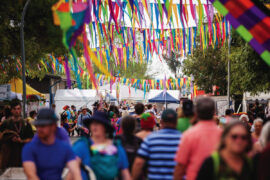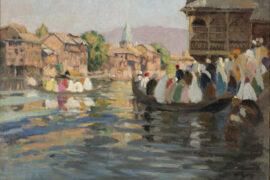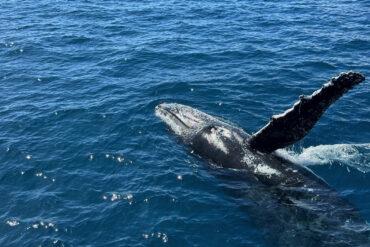Published in The Adelaide Review, October 2004.
Perhaps it’s because I’m being driven around the National Capital in a hearse, but suddenly I’m seeing Canberra through new eyes. My two guides, Allan the Hearse Whisperer and Tim the Yowie Man, have arranged to meet me on a dimly lit street and now they are telling me all sorts of ghostly tales.
First, there’s little Florrie Blundell who died in the front room of Blundells Cottage, built in 1860 for workers on Duntroon Estate. The girl died when her clothes caught alight, and staff at the house – it is now open to the public – say there is sometimes a smell of burning in the room.
At Duntroon House itself, built in 1833 and now housing the Officers’ Mess of the Royal Military College, there is another ghostly story. Sophia Campbell died of bleeding on the brain after falling out of an upstairs window, and Tim, who never gets a nosebleed, has had two while standing near the house.
Tim has spent a lifetime exploring mysteries and he revels in pointing out places such as the Sri Lankan High Commission (formerly a hospital mortuary), the Hotel Kurrajong where Prime Minister Ben Chifley had his fatal heart attack, and the funeral parlour from which ASIO reputedly spied on the Russian embassy during the Cold War.
On we travel, past ScreenSound Australia, said to have had Canberra’s highest number of ghostly sightings, not because of the old films on its shelves, but because the building previously housed the Institute of Anatomy. Did we know that the basement floor was sloped to allow the blood to drain away?
Since my first visit to Canberra nearly 30 years ago, I’ve never thought it was bland or without soul as some critics would have us believe. But this was yet a different perspective on a city I have come to love.
John Howard may have chosen to call Sydney home but frankly he doesn’t know what he has missed out on, for the city offers a wealth of experiences that you’d be hard-pressed to find elsewhere.
Imagine getting close enough to a cheetah to stroke it – that’s one of the thrills for visitors to the National Zoo and Aquarium. Enterprising owner Richard Tindale took a small wildlife park that had mixed fortunes in the 90s and turned it into an exciting attraction withAustralia’s largest collection of big cats and a breeding program for endangered species.
“If you have a passion for cats, it’s all about being in there with them,” says Tindale of people’s willingness to part with $150 for the 15-minute cheetah experience. “It’s a combination of adrenalin rush and the emotional attachment of being in there with them. I do it every day and I never get sick of it.”
The zoo also offers a behind-the-scenes tour and, let me tell you, there is nothing quite like staring down the mouth of a lion or tiger, even if we are separated by a fence.
At the Australian Institute of Sport, the behind-the-scenes tour is usually led by an elite athlete. During my visit, pre-Olympics, swimmer Frances Adcock gave an insight into the lives of the institute’s 360 athletes, about half of whom live on campus. She had been selected to compete inAthensand while we know now that she didn’t win a medal, her excitement at being in the team was palpable.
The AIS tour includes Sportex, an interactive exhibition where you can see how you would fare as a wheelchair basketballer, or how you would measure up to an elite athlete. My hand is three-quarters of the size of basketball player John Dorge’s handprint so I figure I have an excuse for being physically challenged.
If the AIS is home to our sporting giants, Cockington Green is for those who appreciate things small-scale. Set in beautifully tended gardens, this miniature village exceeds all expectations.
In a 30-year labour of love, Doug Sarah and his family have crafted replicas of British buildings, from a Scottish castle and periodSussexhouse toStonehengeand a typical village cricket scene. In recent years, with the support ofCanberra’s foreign embassies, they have added an extraordinary collection of buildings from around the world.
Son Mark saysCanberra“really is a multicultural capital” and his parents are now so popular with the local diplomatic community that they receive a constant stream of invitations to functions. “They start their Christmas parties in October because there are so many to get through.”
Visitors might be surprised to find a sophisticated edge toCanberra, with a great choice of restaurants and outdoor cafes. Afternoon tea at the art deco Hyatt Hotel is a treat, and there is a flourishing wine industry in the region.
To spoil myself on a Sunday, I can enjoy breakfast on the deck of Axis, a restaurant in theNationalMuseumwith glorious views over Lake Burley Griffin. Or I can visit the Old Bus Depot Markets, where the quality and variety of locally made handcrafts and food is astounding.
Culture vultures can have a feast in Canberra and, good news for those with more dash than cash, many attractions are free. Marvel at huge canvases in the National Gallery such as Jackson Pollock’s Blue Poles and David Hockney’s A Bigger Grand Canyon, or opt for a more intimate experience in the National Portrait Gallery.
I am happy with how my taxes have been spent on Parliament House, which has a restrained elegance in its use of marble and beautiful Australian timber. It reveals some treasures, such as a 1297 edition of the Magna Carta, one of only four known to exist from that time.
The National Archives also has some fascinating documents, including the nation’s “birth certificate”, signed by QueenVictoria, proclaimingAustraliaas an independent nation. The National Capital Exhibition at Regatta Point has Walter Burley Griffin’s winning design for the city.
Talking about mysteries, what about Azaria Chamberlain’s black dress? Or Phar Lap’s abnormally large heart? These are on display in theNationalMuseum, where a good half day can be spent delving into our national psyche.
We can learn more about ourselves, too, at the Australian War Memorial, where the most popular exhibit is a World War II Lancaster bomber, G for George, around which a sound and light show has been set. The section onIraqis clearly a work in progress. Here you’ll find one of the famous decks of playing cards depicting theUS’s most wanted.
Stay around for the 5pm closing ceremony when a Scottish piper plays The Last Post in front of the Tomb of the Unknown Soldier. It’s very moving.
For more quiet reflection, I love the National Library, where visitors can browse through the vast reading collection, relax in the café under the beautiful stained glass windows, or attend a talk.
Canberra people love talks. All the major public institutions hold them, but to give an idea, the library recently had one on finding convict ancestors in the library (figuratively speaking of course). Soon there’ll be one on “Sex and Murder in Small Wasps”, definitely one to look out for.
Until November 14, the library has the wonderful Xanadu: Encounters with China exhibition, with maps, pictures, manuscripts and ephemera from its collection. But it is the National Gallery’s blockbuster exhibitions that areCanberra’s biggest drawcard, the next one being the Vivienne Westwood exhibition, from November 12 to January 30.
Exploring three decades of fashion through the eyes of Westwood, one of the world’s most influential designers, there’ll be punk clothing worn by the Sex Pistols, shoes in which Naomi Campbell toppled over on the catwalk, and clothes worn by Sarah Jessica Parker in the television series Sex and the City.
At Old Parliament House, there’s yet more mystery and intrigue. An exhibition on the Petrov Affair, marking the 50th anniversary of the spy drama which shookAustralia’s political landscape, will be on display until April 3. It has ASIO recordings and memorabilia never seen in public before.
Old Parliament House was only ever intended to be a temporary structure, and when the new House was built, there was talk that it should be pulled down. Manager of education and events, Glenda Smith, believes it was worth preserving because of its role in the nation’s formative years.
“When it was turned into a political history museum, it was an acknowledgement that it was the place whereAustraliagrew up.”
Smith remembers a time when parliamentarians and the public used the same entrance. “Until the Hilton Hotel bombing [inSydneyin] the 1970s, people could just walk up the front steps and mingle with the parliamentarians in Kings Hall.”
For better or worse, Canberra and Australia have grown up.
Fact File:
Accommodation: Canberra Getaways 1800 100 660.
Tourist information: 1300 554 114 or www.visitcanberra.com.au
www.capitalcountry.com.au
Canberra and Region Visitors Centre: 330 Northbourne Ave, Dickson.
Weird Canberra Ghost and History Tour with Tim the Yowie Man: 0414 232244.
Wine information: www.canberrawines.com.au
Privileges Card offers sizeable discounts for dining out, entertainment and attractions. It costs $35 for 30 days: +61 (2) 6161 1999 or www.TheCard.com.au
© Christine Salins




